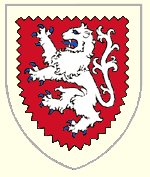Thomas Grey (of Heaton)
|
Sir Thomas Grey of Heaton |
|
|---|---|

Arms of Sir Thomas Grey of Heaton:- gules, a lion rampant and a bordure indented argent: variation - a baton azure Crest:- 1: Scaling Ladder 2: Rams Head
|
|
| Died | bef. Mar 1344 |
| Allegiance | England |
| Service/branch | Army |
| Rank | Knight Banneret |
| Commands held | Warden of Cupar Castle Keeper of Norham Castle Deputy Constable of Berwick-upon-Tweed Keeper of Mitford Castle |
| Battles/wars |
Action at Lanark (1297) Siege of Stirling Castle (1304) Ambush at Cupar Castle (1308) Battle of Bannockburn (1314) Capture of Berwick (1318) Siege of Norham (1322) Invasion of England (1326) |
| Spouse(s) | Agnes de Bayles |
| Relations | Thomas Grey (chronicler) |
Sir Thomas Grey of Heaton, Northumberland was a soldier who served throughout the Wars of Scottish Independence. His experiences were recorded by his son Thomas and provide a rare picture of the day to day realities of the wars. His career was blemished by his suicidal charge at the Battle of Bannockburn, which was a contributing factor to the devastating English defeat, but is perhaps best known for his role in the tale of Sir William Marmion the chivalric knight of Norham Castle.
Thomas was serving under William de Hesilrig, Sheriff of Clydesdale as early as 1297. Following William Wallace's nighttime assassination of the Sheriff at Lanark, Gray was left for dead, stripped naked in the snow. He only survived because of the heat from the houses burning around him and was rescued the next day and his wounds healed.
Thomas was knighted before September 1301 and served with the King's Lieutenant for Scotland, Patrick IV, Earl of March at Ayr.
In May 1303 Sir Thomas found himself under the command of Hugh de Audley encamped at Melrose Abbey when they were attacked at night by a much larger force led by John Comyn. Grey was beaten to the floor and taken prisoner but most of his comrades were slain.
Edward I had captured most of Scotland by April 1304 and embarked upon a nineteen-week siege of the last significant uncaptured fortress at Stirling Castle using twelve siege engines which included the massive trebuchet called "Warwolf".
...
Wikipedia
